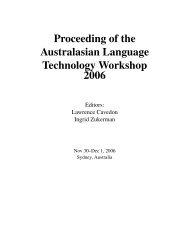The MBC information booklet - RMIT University
The MBC information booklet - RMIT University
The MBC information booklet - RMIT University
You also want an ePaper? Increase the reach of your titles
YUMPU automatically turns print PDFs into web optimized ePapers that Google loves.
12.1.4 COSC2354—<br />
Electronic<br />
Commerce &<br />
Enterprise<br />
Systems<br />
12.1.5 ISYS1106—<br />
Engineering<br />
Software<br />
Projects<br />
12.1.6 COSC1125—<br />
Introduction to<br />
Artificial<br />
Intelligence<br />
12.1.7 COSC2347—<br />
Mobile<br />
Application<br />
Development<br />
Course Description<br />
Chapter 12: Vocational Electives<br />
This course introduces the concepts and technologies necessary to understand and<br />
implement electronic commerce and enterprise systems in Java J2EE. Emphasis is<br />
placed upon the development, deployment and usage of such systems over TCP based<br />
infrastructure in both intranet and internet applications. <strong>The</strong> primary function of this<br />
course is that of teaching, investigating and enabling, and while students will do practical<br />
work involving the writing of a small complete system using JSP (Java Server Pages)<br />
and EJB (Enterprise JavaBeans).<br />
Pre-requisite Courses and Assumed Knowledge and Capabilities<br />
• Introductory Java Programming, such as COSC1295 Java for Programmers<br />
• ISYS1059 Introduction to Internet Technology<br />
OR<br />
COSC1309 Programming Web Applications<br />
OR<br />
course leader approved equivalent<br />
For more <strong>information</strong> on the course, go to www.rmit.edu.au/courses2006/014053.<br />
Course Description<br />
This course is designed to educate students about the principles and practices in the<br />
management of software engineering projects and how this relates to people,<br />
organisations, and software processes.<br />
Pre-requisite Courses and Assumed Knowledge and Capabilities<br />
• ISYS1117 Software Engineering Analysis and Design<br />
For more <strong>information</strong> on the course, go to www.rmit.edu.au/courses2006/004245.<br />
Course Description<br />
This course introduces the basic concepts and techniques of Artificial Intelligence.<br />
Artificial intelligence is the sub area of computer science devoted to creating software<br />
and hardware to get computers to do things that would be considered intelligent as if<br />
people did them. Artificial intelligence has had an active and exciting history and is now<br />
a reasonably mature area of computer science. Many of the research discoveries have<br />
now reached the point of industrial application and products. Many companies have<br />
made and saved millions of dollars by exploiting the results of artificial intelligence<br />
research. However the goal of emulating human intelligence has not been reached and<br />
many stimulating and challenging problems remain.<br />
Pre-requisite Courses and Assumed Knowledge and Capabilities<br />
• Students are required to have advanced programming skills, in both Java and C,<br />
together with a sound grasp of the fundamentals of the theory of computing before<br />
commencing this course. This includes data structures and algorithms (such as<br />
balanced trees, hash tables, quicksort, and mergesort), tractable and intractable<br />
problems, heuristic approaches to problem solving and undecidability. Familiarity<br />
with Unix and C is strongly recommended. Completion of both of the following<br />
courses will satisfy the pre-requisite requirements.<br />
• COSC1105 Computing <strong>The</strong>ory<br />
• COSC1285 Advanced Programming Techniques<br />
For more <strong>information</strong> on the course, go to www.rmit.edu.au/courses2006/004123.<br />
Course Description<br />
This course is concerned with the development of applications on mobile and wireless<br />
computing platforms. Java will be used as a basis for teaching programming techniques<br />
and design patterns related to the development of standalone applications and mobile<br />
portals to enterprise and m-commerce systems.<br />
Emphasis is placed on the processes, tools and frameworks required to develop<br />
applications for current and emerging mobile computing devices. Students will work at all<br />
stages of the software development life-cycle from inception through to implementation<br />
61
















